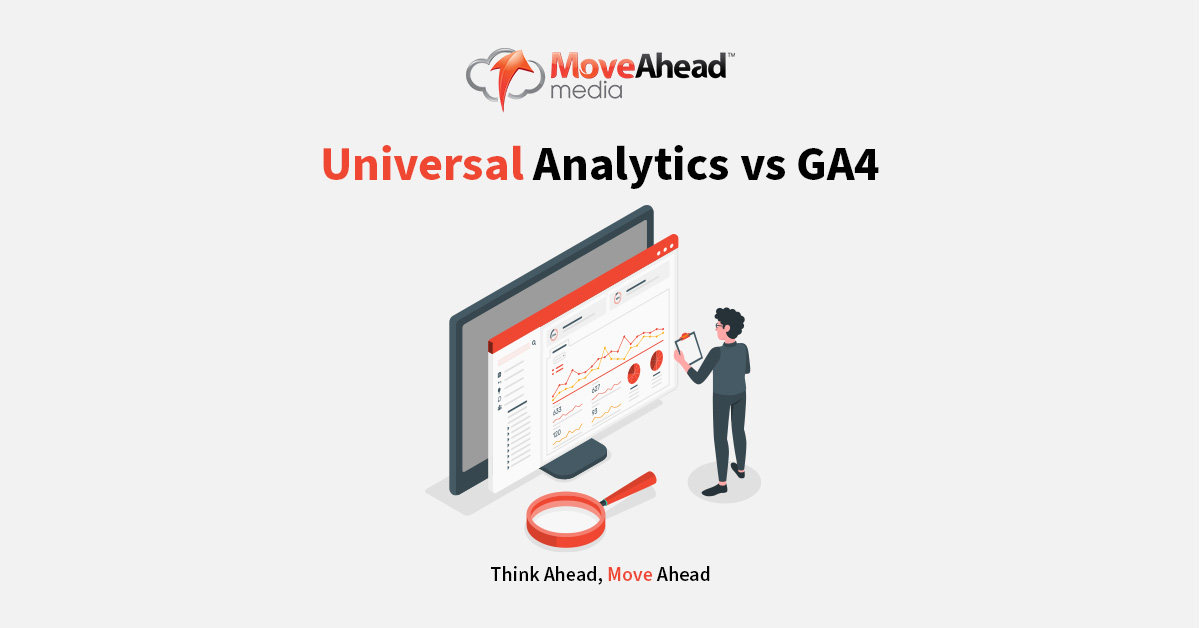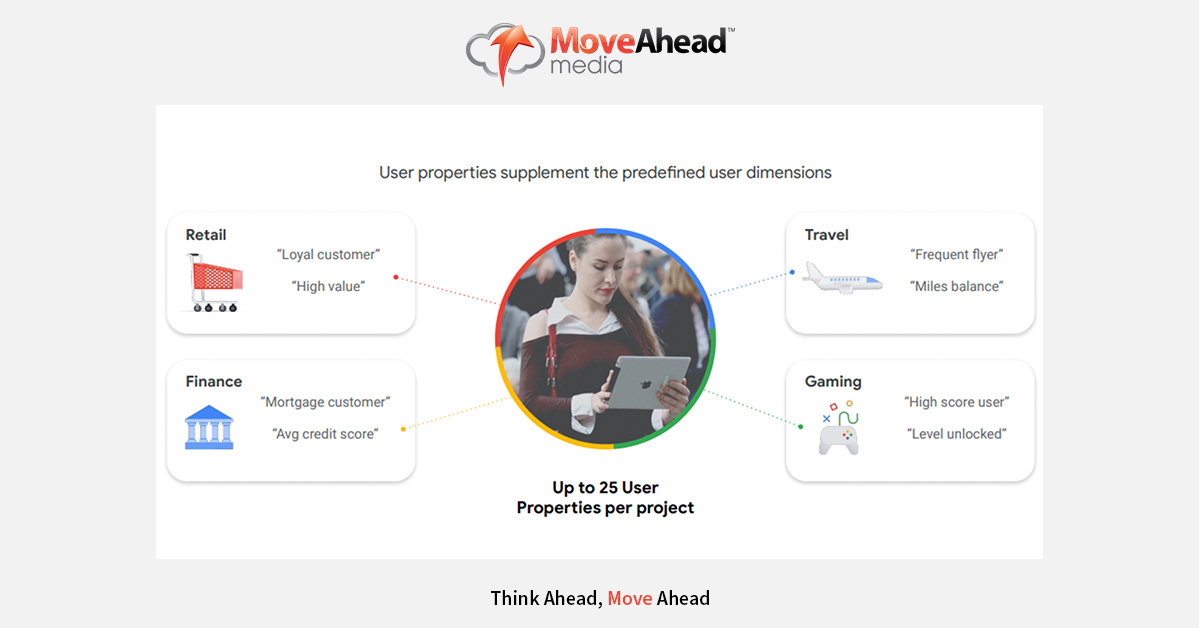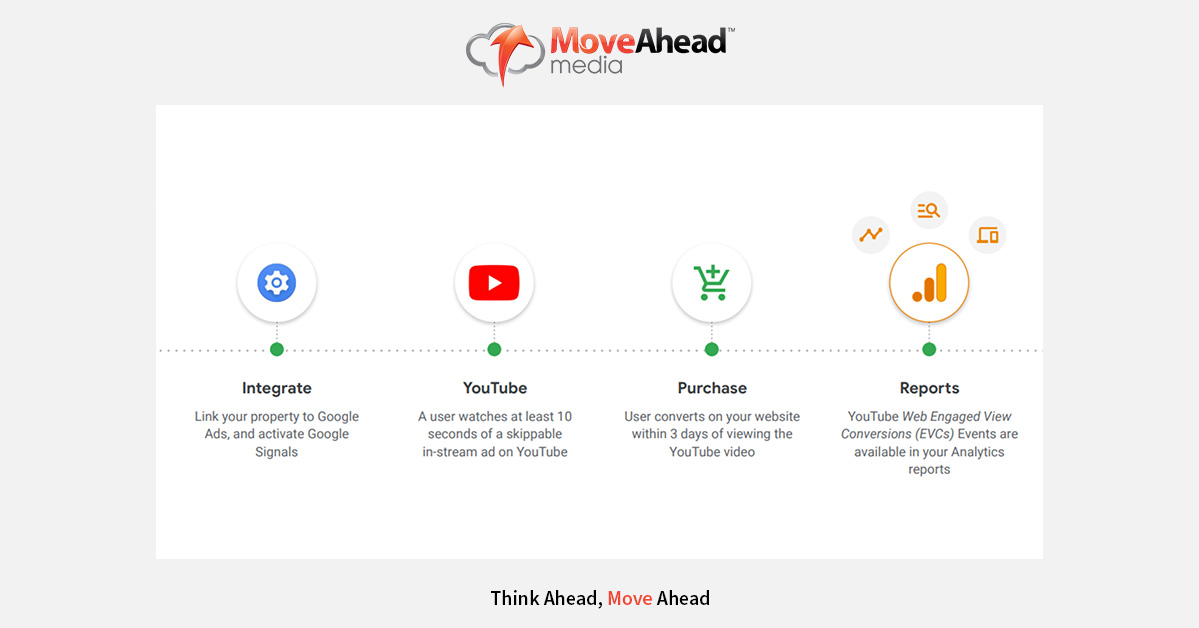
Universal Analytics vs GA4
Contents
- 1 What Is Google Universal Analytics?
- 2 What Is GA4?
- 3 What Are The Key Differences Between Universal Analytics And GA?
- 4 Why Upgrade To Google Analytics 4 Now?
- 5 You Are Probably Wondering What Happens To Your Current Universal Analytics?
- 6 Manage And Analyze Data With A New Reporting UI
- 7 How To Set Up Google Analytics 4

Google Analytics is changing. Again. Universal Google Analytics, the tried and tested platform used for years by businesses all over the world to measure website performance, is soon to be replaced by GA4 – or Google Analytics 4, as it’s more commonly known. But what does this mean for you? And how will your data be protected in a post-GDPR world? In this blog post, we’ll take a look at the differences between Universal and GA4 Analytics, and explain why you should make the switch as soon as possible.
The message from Google is that “We live in a new world of measurement”. Ultimately Google knows that the future consented and user expectation on Privacy has impacted the way all marketing is measured. Cookies will become more scarce and First Party data is key. Google is using these facts as a guide for the next-gen of its products and solutions around tracking.
Let’s start from the beginning as some of our readers may be first-time users of Google Analytics and we want to cater to all audiences.
What Is Google Universal Analytics?
Universal Analytics is a Google analytics tool that allows you to collect more data about your website visitors and better understand their behavior. With Universal Analytics, you can track interactions across devices and platforms, get more insights into customer behavior, and better assess the effectiveness of your marketing campaigns.
Universal Analytics has been around for a while now, and most businesses are already using it to track their website performance. However, Google has announced that Universal Analytics will be replaced by GA- or Google Analytics- in the near future.
What Is GA4?

GA4 takes a different approach to data collection and reporting than what you are used to seeing in Universal Analytics (UA). The backbone of this platform is built on the App + Web kit, or Firebase for short. It has some unique features that make it stand out from other analytical tools such as UA like real-time inspection during your campaign’s lifecycle so there will be no surprises when users start engaging with content.
With Google’s new approach, marketers are being encouraged to rethink how they interpret user data by changing it over from the ‘event-based model. In this way of collecting and presenting information about users’ journeys on their site or app more than any other before them– Data collected through these reports will now focus very specifically on events that take place throughout your journey while browsing with GA4 as opposed just solely focusing what happens at each point within those interactions where you have logged into an account/ Visitors can expect better insights because all aspects including timing between different pieces go towards creating one complete picture which ultimately provides greater value both ways.
What Are The Key Differences Between Universal Analytics And GA?

The key difference between UA and GA is in the way data is collected. With UA, data is collected via the web browser (e.g. JavaScript tags) or mobile SDKs. GA, on the other hand, uses a different approach called “event-driven collection”. Previously Universal analytics was a session-based data model.
Let us take a look at some of the main differences between the 2 Google Analytics Properties.
HIT TYPES & EVENTS
Universal Analytics hit types include page hits, event hits, eCommerce hits, and social interaction hits.
In contrast, Google Analytics 4 data is event-based, with the principle that any interaction can be captured as an event. As such, Universal Analytics property hit types translate to events in a Google Analytics 4 property.

SESSIONS
Sessions in Universal Analytics are defined by a number of different events, including page views and eCommerce transactions. A session will end when there’s been an 30 minute period without any activity
Google Analytics 4 session metrics are derived from the session_start event. This is one of Google Analytics 4 automatically collected events. Sessions then last for the duration of time it takes between your first and last event in Google Analytics 4.
In Google Analytics 4 there are differences in how sessions are counted. Previously in Universal analytics, a new campaign will start a new session regardless of activity. Now in Google analytics 4, a new campaign does not start a new session. The result of this is that you will now start to see fewer sessions in your Google analytics 4 account as opposed to your Universal analytics.
USER PROPERTY (Google Analytics 4 Properties)

GA4 Can automatically log some of the most important user properties, such as language preference and geographic location. With the new Google Analytics property, you are able to add user attributes to further segment users for more detailed reporting and segmentation of user behaviour and customer journey.
USER ID

The Google Analytics 4 properties feature allows you to see how users interact with your app or website on a cross-platform, device level. You have the option of generating unique persistent ids and including them alongside data that is sent into google analytics, so they can track individual user journeys more efficiently than before without having multiple logged-in sessions going toward one person’s information such as their email address, etc… This new way will help provide much better insight because it takes everything into account from where people come from (homepage) right down every action taken inside Your site while also providing insights about what kinds of events tend to lead towards certain goals
Google is also looking to offer a much more accurate cross-platform view of businesses data. In the past, businesses have been left with data silos between their website and mobile app which has made it difficult to get an accurate view of the customer journey. GA4 will solve this problem by creating a single user journey from all of the data associated with the same User-ID.
You are probably wondering how Google analytics 4 will be able to track users across multiple devices? Google Signals are session data from the sites and google properties associated with users who are signed in. . Google Platforms record user interactions across multiple devices that they are signed into whilst viewing your property.
Why Upgrade To Google Analytics 4 Now?
All Universal Analytics (UA) properties will stop processing new hits on July 1, 2023 for standard properties and October 1, 2023 for 360 properties (3 months later). UA will then become read-only through H1 2024 and users will no longer be able to access their UA properties from July 1st 2024. Once a customer signs a GA4 contract, they will have at least 6m before their UA property is downgraded.
Google Analytics 4 will be key to helping businesses measure what matters. GA4 has the flexibility to measure many different kinds of data, delivering an analytics experience that’s designed for the future. It allows businesses to see unified user journeys across web and app, it uses Google’s machine learning technology to the surface and predicts new insights, and most importantly, it’s built to keep up with a changing ecosystem.
The Future Of Analytics
Google Analytics 4 has been designed to be the most effective and efficient for an evolving ecosystem, with machine learning at its core
New Innovations
The next generation of Google Analytics just got a whole lot more powerful with all-new features that are exclusive only to GA4 vs universal analytics.
Cookieless Insights
Google Analytics 4 will provide privacy-safe customer insights with or without cookies. This is extremely important in a world where data privacy is more important than ever before.
You Are Probably Wondering What Happens To Your Current Universal Analytics?
Your current Universal Analytics will continue to work alongside GA for the foreseeable future. However, it is important to note that UA will eventually be phased out and replaced by GA. Google has not yet announced a date for when this will happen, but it is expected that UA will become obsolete within the next few years.
We recommend setting up dual Set Up and running your GA4 alongside your Universal Analytics property:
– Dual setup is an implementation process where a Google Analytics 4 property is deployed on web alongside an existing Universal Analytics (UA) property.
– Upon completing this process, a website’s measurement data is sent to both the UA and Google Analytics 4 property.
– Customers should continue using the UA property as the source of truth until all relevant use cases are available in GA4.
DATA STREAMS
With Google Analytics 4, the structure is pretty different from Universal analytics. Where before you had views and now have data streams!
So What Are Data Streams In Google Analytics 4?
A data stream is a configuration within Google Analytics that receives data from an identified source. When you create a GA property, you’re prompted to select a data stream type. The types are web, app, and AMP (Accelerated Mobile Pages). You can also create streams for other sources such as CRM systems, IoT devices, and so on.
There are two types of data in each stream:
– User data: Information about users and their interactions with your site or app, such as page views, events, eCommerce transactions, and so on.
– Event data: Actions that happen on your site or app, such as page view events, button clicks or form submissions
Enhanced Measurement Events in Data Streams

Google has a number of Automatically collected events that will start from the minute you implement your GA4 Tag. These are default and do not require any extra code as long as you use the Global Site Tag.
There are also enhanced measurement events. These are events that you, the site owner, have deemed important enough to track. Luckily with Google Analytics 4 you no longer need to add any additional code for these.
You can simply turn on the events from within your GA interface. Google Analytics will then start tracking these events without you having to do any extra work!
This is a huge time saver for those of us who want to track specific interactions on our site but don’t have the coding skills or knowledge to do so.
Some examples of Enhanced measurement events are:
- Outbound_link_click
- Site_search
- Embedded Video Engagement metrics
Manage And Analyze Data With A New Reporting UI
In your new GA4 Google Analytics Account, you will find that the reporting interface is slightly different from Universal analytics. Unlike Universal Analytics, GA4 has a much simpler reporting interface. Google analytics 4 encourages users to customize default reports to view event metrics that matter to your business.
The new Google Analytics property boasts a great new feature, giving access to predictive metrics for Audiences and Analysis. Using Machine learning Google Analytics 4 offers a number of Predictive metrics that can help future proof your marketing and anticipate changes in your customer behaviours.

YouTube Integration and Tracking within Analytics

Previously only Google ads would track any View Through Conversions with Google ads hosted tags. Google Analytics 4 is the First ever direct integration tracking with Youtube. This is a direct integration that will show all of your video view data directly in Google Analytics. This was not possible with Universal Analytics. You would have to use the YouTube API to get this data, which was difficult and time-consuming.
How To Set Up Google Analytics 4
We are expecting 2 types of readers here… People who are brand new to Analytics all together and those that have been using Universal Analytics for a while. You may also be using Google Analytics 4 for your Website and/or App.
Brand New To Analytics
Step 1: Make your way to the Analytics Homepage. – https://analytics.google.com/analytics/
Step 2: Head to the Admin Section and click “Create Account” or “Start Measuring”
Step 3: Name Your Account and Property
Step 4: Ensure you select the correct timezone and Currency
Step 5: Choose your business information and what you intend to use analytics for….

Step 6: Setting up Your Data Stream to Start Collecting Data

step 7: Ensure your enhanced measurement tracking is switched on

Step 8: Final step is to set up Your Tag. This can be done un the head of your HTML or in Google Tag Manager

There are 2 options for adding the Snippet. If you want to add directly into your Google Tag Manager already on your site. Open the Google Tag Manager container that’s implemented on your page and follow the instructions below.

Adding A GA4 To Your Normal Universal Analytics
Step 1: Go to the admin section of your existing Universal analytics.
Step 2: In the Property collumn the top option is “GA4 Set Up Assistant”

You will be prompted with this comforting message after clicking “Get Started”

Step 3: You will now need to install your Property ID which no longer starts with “UA” but a simple G-XXXXXXX. This can be done by adding to Tag Manager or the HTML in your site.
Step 4: Once this is done you will want to ensure you are tracking all Important User interactions and events.
Like with Univeral Analytics you will want to track Conversions, Audiences and most importantly the granular events and custom events to make the most of the new GA4 Platform.

To Conclude
So there you have it, the main differences of Google Analytics 4 vs universal analytics and how to set the new Google analytics property up. The next step is getting to use GA4 and we will cover this in a different blog, on “How to Use GA4 Analytics”. If you are struggling with any of the information above or implementation of it. Then feel free to reach out to the experts at Move Ahead Media and we can help with all the tracking and analysis of your business.






